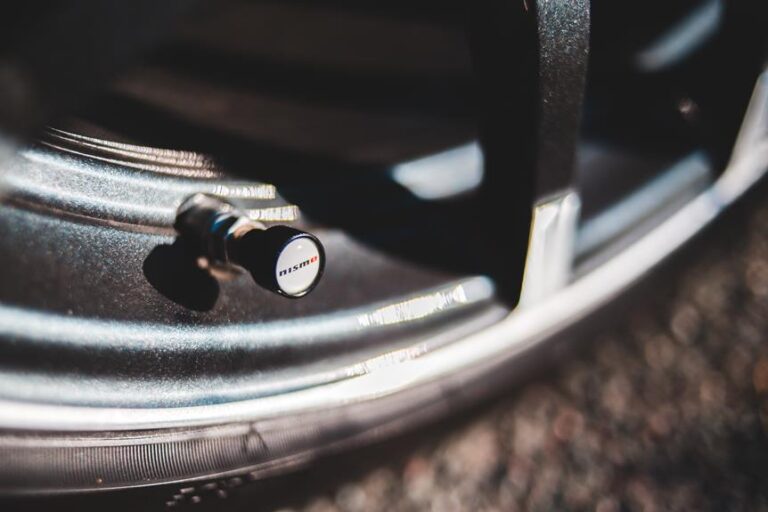Improving Handling and Grip With the Right Tires
In the realm of automotive performance, the quest for handling and grip is akin to a master swordsman seeking the perfect blade. Like a finely honed weapon, the right tires can make all the difference in delivering precision and control on the road.
This article explores the intricate world of tire technology, from understanding tread patterns to selecting the optimal tire compound. Whether you desire the thrill of high-performance driving or simply value safety, discover how the right tires can unlock a new level of handling and grip.
Key Takeaways
- Tire tread patterns and size/fitment play a crucial role in improving handling and grip.
- Different tire types (all-season, summer, winter) offer unique benefits and performance characteristics.
- Choosing the right tire compound is essential for enhancing handling and grip.
- High-performance tires provide exceptional grip, handling, and stability on the road.
Understanding Tire Tread Patterns
In order to enhance vehicle safety and performance, it is crucial for drivers to have a comprehensive understanding of the various tire tread patterns and their impact on traction and stability. Tire tread wear and design play a significant role in determining how well a vehicle grips the road, especially in adverse weather conditions.
Tire tread wear refers to the gradual erosion of the tire surface due to friction with the road. As the tread wears down, the tire's ability to maintain traction decreases, resulting in reduced stability and increased stopping distances. To counteract this, tire manufacturers employ different tread designs to maximize grip and performance.
The design of tire treads is carefully engineered to provide optimal traction in different driving conditions. For example, tires with deep grooves and aggressive patterns are suitable for off-road or muddy terrains, as they can effectively channel away water, mud, and debris, preventing hydroplaning. On the other hand, tires with shallower, more closely spaced grooves are better suited for dry or paved surfaces, as they offer increased contact area and better handling.
The Importance of Tire Size and Fitment
During the discussion on the importance of tire size and fitment, it is crucial for drivers to consider the specific measurements and compatibility of their tires to ensure optimal performance and safety. Proper tire fitment involves selecting the right tire size for your vehicle, taking into account factors such as load capacity, speed rating, and overall diameter.
To help drivers make informed decisions, the following table provides an overview of common tire sizes and their corresponding fitment parameters:
| Tire Size | Load Capacity (lbs) | Speed Rating | Overall Diameter (in) |
|---|---|---|---|
| 205/55R16 | 1,201 | V | 24.9 |
| 225/45R17 | 1,477 | W | 25.0 |
| 245/40R18 | 1,653 | Y | 25.7 |
| 265/35R19 | 1,709 | Y | 26.3 |
| 275/30R20 | 1,653 | Y | 26.5 |
By selecting the appropriate tire size and ensuring proper fitment, drivers can optimize handling, grip, and overall performance. It is important to consult the vehicle manufacturer's recommendations and consult with a tire professional to ensure the best tire size selection for your specific vehicle.
Transitioning into the subsequent section on exploring different tire types, it is important to understand that tire size is just one aspect of tire selection. In addition to tire size, drivers must also consider the type of tire that suits their needs, such as all-season, summer, or winter tires.
Exploring Different Tire Types: All-Season, Summer, and Winter
Drivers should carefully consider the specific features and performance characteristics of all-season, summer, and winter tires in order to make an informed decision about which tire type is most suitable for their driving needs. Each tire type offers unique benefits and is designed to perform optimally in different weather conditions.
All-season tires are a popular choice for drivers looking for versatility and convenience. They are designed to provide good performance in both wet and dry conditions, as well as light snow. All-season tires typically have a tread pattern that offers a balance between traction and fuel efficiency.
On the other hand, summer tires are specifically designed for warm weather conditions. They have a tread pattern that provides excellent grip on dry roads, ensuring precise handling and cornering. However, summer tires may not perform as well in colder temperatures or on wet surfaces, so they are not recommended for use in winter conditions.
Winter tires, also known as snow tires, are designed to provide optimal traction in cold weather, ice, and snow. They have a unique rubber compound that remains flexible even in freezing temperatures, allowing the tread to grip the road effectively. Winter tires also have deeper tread patterns with more sipes, which improve traction on snowy and icy surfaces.
Choosing the Right Tire Compound for Enhanced Handling
Regularly assessing and comparing tire compounds is crucial for optimizing handling performance. When it comes to tire compound selection, it is important to consider the specific needs and driving conditions.
Different tire compounds offer varying levels of grip and performance characteristics, allowing drivers to tailor their tires to their desired driving experience.
Tire grip optimization is a key factor in improving handling and overall driving performance. The right tire compound can greatly enhance traction, allowing for better control and responsiveness on the road. By selecting a tire compound that offers high levels of grip, drivers can experience improved cornering ability, shorter braking distances, and enhanced stability.
There are various types of tire compounds available, each designed to excel in specific conditions. For example, summer tires are known for their superior grip on dry pavement, while winter tires are optimized for traction on snow and ice. High-performance tires, on the other hand, are designed to provide exceptional grip and handling capabilities in a variety of driving conditions, making them a popular choice for enthusiasts and those seeking the best performance from their vehicles.
In the next section, we will delve into the benefits of high-performance tires and how they can further enhance handling and grip on the road.
The Benefits of High-Performance Tires
Additionally, high-performance tires offer exceptional grip and handling capabilities, consistently improving the overall driving experience. These tires are designed using advanced technologies and high-quality materials, resulting in enhanced traction and responsiveness on the road. Here are some key benefits of upgrading to high-performance tires:
- Enhanced Grip: High-performance tires utilize specialized tread patterns and rubber compounds that provide superior traction, allowing for better control of the vehicle in both wet and dry conditions.
- Improved Handling: These tires have stiffer sidewalls and reinforced construction, which minimize tire flexing during cornering and provide precise steering response. This translates to better handling and increased confidence while driving.
- Upgraded Suspension Compatibility: High-performance tires are often designed to work in conjunction with upgraded suspension systems, optimizing the overall performance of the vehicle and ensuring a smooth and comfortable ride.
To fully harness the benefits of high-performance tires, it is important to regularly maintain them using proper tire maintenance techniques. This includes regular inspections to check for any damage or signs of wear, as well as maintaining the recommended tire pressure. Exploring tire pressure and its impact on grip is crucial, as underinflated or overinflated tires can negatively affect the tire's contact patch with the road surface, leading to reduced grip and compromised handling.
Exploring Tire Pressure and Its Impact on Grip
When it comes to maximizing grip and tire performance, tire pressure plays a crucial role. Properly inflated tires distribute weight evenly across the contact patch, ensuring optimal traction and grip.
Understanding the impact of tire pressure on grip will help drivers make informed decisions to enhance their driving experience and safety.
Optimal Tire Pressure
Maintaining the recommended tire pressure of 32 psi is crucial for maximizing grip and achieving optimal handling performance. It is important to regularly monitor tire pressure to ensure it stays within the recommended pressure range.
Here are some key reasons why maintaining proper tire pressure is essential:
- Safety: Proper tire pressure ensures better traction and grip, reducing the risk of accidents, especially in wet or slippery conditions.
- Fuel Efficiency: Underinflated tires increase rolling resistance, leading to decreased fuel efficiency. By maintaining the correct tire pressure, you can improve fuel economy and save money at the pump.
- Tire Longevity: Overinflated or underinflated tires can wear unevenly, reducing their lifespan. By keeping the tires properly inflated, you can extend their longevity and save money on replacements.
Grip and Tire Performance
Improving grip and tire performance is crucial for enhancing vehicle control and safety on the road. When it comes to tire grip, two important factors to consider are wet surface conditions and icy roads. These conditions can significantly impact how well your tires adhere to the road, ultimately affecting your ability to maintain control of your vehicle.
To better understand the importance of tire grip, let's look at a comparison table showcasing the grip performance of different tires on wet surfaces and icy roads:
| Tire Brand | Wet Surface Grip | Icy Road Grip |
|---|---|---|
| Brand A | High | Moderate |
| Brand B | Moderate | High |
| Brand C | Low | Low |
| Brand D | High | High |
| Brand E | Moderate | Moderate |
As you can see from the table, tire grip can vary greatly depending on the brand and type of tire. It is essential to choose tires that provide adequate grip on both wet surfaces and icy roads to ensure optimal control and safety while driving. Remember, investing in high-performance tires designed for these conditions can greatly improve your driving experience and give you the freedom to confidently navigate any road conditions.
The Role of Tire Rotation in Maintaining Handling and Grip
Tire rotation plays a crucial role in enhancing the overall performance of a vehicle's handling and grip. By regularly rotating the tires, the wear on each tire is distributed more evenly, preventing uneven wear patterns that can negatively affect handling and grip. This simple maintenance task offers several benefits, including:
- Extended Tire Life: Regular tire rotation helps to prevent uneven wear, which can lead to premature tire replacement. By rotating the tires at recommended intervals, the tread wear is distributed evenly across all tires, maximizing their lifespan.
- Improved Handling: Unevenly worn tires can cause imbalances in handling and grip, leading to a less stable and responsive driving experience. By rotating the tires, the vehicle maintains a more balanced grip on the road, enhancing overall handling and control.
- Enhanced Traction: Unevenly worn tires can also lead to reduced traction, especially in wet or snowy conditions. By rotating the tires, the tread wear is equalized, ensuring consistent traction and grip on all four wheels.
- Reduced Tire Noise: Unevenly worn tires can produce excessive noise, resulting in a less comfortable driving experience. By regularly rotating the tires, the noise generated by uneven wear is minimized, promoting a quieter ride.
Overall, tire rotation is a simple yet effective way to maintain the handling and grip of a vehicle while preventing premature tire wear. By following the recommended rotation patterns and intervals provided by the tire manufacturer, drivers can ensure optimal performance and safety on the road.
Upgrading to Performance Tires: What You Need to Know
What considerations should drivers take into account when upgrading to performance tires?
When upgrading to performance tires, drivers should consider several factors to ensure they make the right choice for their vehicle and driving style.
One important consideration is the type of tires to upgrade to, such as upgrading to run flat tires. Run flat tires are designed to allow drivers to continue driving even after a puncture, providing increased safety and peace of mind.
Another consideration is the impact of tire treadwear rating. The treadwear rating indicates the expected lifespan of the tire, with higher ratings indicating longer-lasting tires. Drivers should choose a treadwear rating that aligns with their driving habits and mileage expectations.
Additionally, drivers should consider the performance characteristics they desire, such as improved handling and grip. It is important to select tires that offer the desired level of traction, responsiveness, and cornering ability.
Lastly, drivers should also consider their budget and prioritize their needs and preferences accordingly.
Enhancing Handling and Grip With Tire Maintenance and Care
Maintaining optimal tire pressure, monitoring tread depth, and regularly rotating tires are essential steps in enhancing handling and grip.
Proper tire pressure ensures even distribution of weight and contact with the road surface, maximizing traction.
Monitoring tread depth helps determine the tire's ability to grip the road.
Rotating tires promotes even wear, prolonging their lifespan and maintaining consistent performance.
Tire Pressure Importance
Properly monitoring and adjusting the pressure of your vehicle's tires is crucial for optimal performance and safety. Maintaining the correct tire pressure ensures that your vehicle handles well, provides sufficient grip, and reduces the risk of accidents.
There are several reasons why tire pressure maintenance and monitoring should be a priority:
- Improved Fuel Efficiency:
Properly inflated tires reduce rolling resistance, which in turn improves fuel efficiency and saves you money at the pump. Underinflated tires can increase fuel consumption by up to 3%.
- Extended Tire Lifespan:
Correct tire pressure helps distribute weight evenly across the tire, reducing wear and tear. Overinflated or underinflated tires wear unevenly, leading to premature tire replacement.
Tread Depth and Grip
Significantly, ensuring proper tread depth and grip is essential for maximizing handling and control on the road. Tires with worn-out treads can result in reduced traction, longer braking distances, and compromised stability. Therefore, it is crucial to regularly inspect your tires and be aware of the tread wear indicators. These indicators are small raised bars located in the tire's grooves, which become visible when the tread wears down to a certain level. To assess your tire's traction, tire traction tests can be conducted. These tests measure the grip levels of your tires on different road surfaces, allowing you to determine if it's time for new ones. By maintaining adequate tread depth and grip, you can ensure safer and more enjoyable driving experiences, giving you the freedom to navigate the roads with confidence.
| Column 1 | Column 2 | Column 3 |
|---|---|---|
| Wet | Dry | Snow |
| Excellent | Excellent | Good |
| Good | Good | Good |
| Fair | Fair | Fair |
| Poor | Poor | Poor |
| Dangerous | Dangerous | Dangerous |
Rotating Tires for Longevity
How can tire rotation contribute to the longevity of tires and improve handling and grip?
Tire rotation techniques play a crucial role in increasing tire lifespan and enhancing overall performance. Here are two key benefits of regular tire rotation:
- Even tread wear: Tires tend to wear unevenly due to factors like weight distribution, alignment issues, and driving habits. Rotating tires regularly helps distribute the wear more evenly, ensuring that all tires wear at the same rate. This promotes longevity by preventing premature wear on specific tires.
- Improved handling and grip: Unevenly worn tires can lead to reduced traction and handling capabilities, compromising safety on the road. By rotating the tires, the tread wear is spread out, allowing for consistent grip and handling performance across all tires. This contributes to a smoother and safer driving experience.
Frequently Asked Questions
Can I Use Winter Tires All Year Round?
Using winter tires all year round is not recommended as they are specifically designed for cold weather conditions. Winter tires provide better traction, handling, and braking on snow and ice, but they wear out faster on dry and warm roads.
How Often Should I Rotate My Tires?
Proper tire maintenance is crucial for optimal performance and longevity. Tire rotation frequency depends on various factors such as vehicle type, driving conditions, and tire wear patterns. Consult your vehicle's manufacturer guidelines for the recommended interval.
Can I Mix Different Tire Types on My Vehicle?
Mixing different tire types on a vehicle can have both advantages and disadvantages. While all-season tires offer versatility, using summer tires in winter conditions can compromise grip and handling. It's important to choose the right tires for optimal performance and safety.
Does Tire Pressure Affect Fuel Efficiency?
Tire pressure plays a crucial role in fuel efficiency. Underinflated tires increase rolling resistance, forcing the engine to work harder and consume more fuel. Proper tire maintenance, including regular pressure checks, reduces tire wear and improves fuel economy.
How Long Do High-Performance Tires Typically Last?
High-performance tires typically last around 20,000 to 40,000 miles, depending on driving habits and road conditions. It is important to regularly inspect tires for signs of wear, such as uneven tread wear or cracking, to ensure optimal performance and safety.
Conclusion
In conclusion, selecting the right tires plays a crucial role in improving handling and grip. Understanding tire tread patterns, size and fitment, and different tire types such as all-season, summer, and winter are essential factors to consider.
Additionally, choosing the appropriate tire compound, maintaining proper tire pressure, and regularly rotating tires contribute to enhanced handling. Upgrading to high-performance tires can further enhance grip. Taking care of tires through maintenance and care also ensures optimal performance.
An interesting statistic to engage the audience is that proper tire maintenance can increase tire lifespan by up to 20%.







